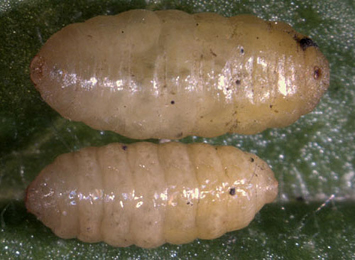|
||||||
|
LEVISTICUM. Lovage. [Apiaceae] |
|
Only one species of Levisticum, Lovage (L. officinale), is recorded in Britain and this is introduced. Five or six British miners are recorded on Levisticum. A key to the European miners recorded on Levisticum is provided in Bladmineerders van Europa. |
Key for the identification of the known mines of British |
1a > Leaf-miner: A large blotch, yellow or brown, preceded by a short corridor that in the end mostly is completely overrun. Generally several larvae share a mine. Especially in fresh mines the green primary and secondary feeding lines are well visible. Pupation outside the mine. Puparium yellow. |
 Euleia heraclei pupariria Image: © Willem Ellis (Bladmineerders van Europa) |
|
Euleia heraclei (Linnaeus, 1758) [Diptera: Tephritidae]. |
1b > Leaf-miner: A short, irregular, linear upper surface mine on any part of the leaf. Also recorded from young pods (Bland, 1997a). Long corridor mine. As a rule the first part of the mine is lower-surface, the later part upper-surface. Often the loops are so dense that a secondary blotch is the result. Because upper- and lower-surface corridor segments often cross, the mine obtains a strange array of transparant patches. There is no association with the midrib. Frass in strings and thread fragments. Pupation outside the mine; exit slit in upper epidermis. Mine not associated with the veins or midrib of the leaf (It is this character which enables distinction from another Agromyzid pest species - Liriomyza huidobriensis). The larvae may leave one leaf (if not large enough) and enter another leaf, via the petiole). It exits the leaf to pupate through a semi-circular slit in the upper surface of the leaf. |
|
Liriomyza bryoniae (Kaltenbach, 1858) [Diptera: Agromyzidae]. |
1c > Leaf-miner: Mine linear, whitish, both upper and lower surface. Pupation internal, at the end of the mine with the anterior spiracles projecting through the epidermis (Spencer, 1976: 433). Upper-surface, less often lower-surface corridor. Frass in isolated grains. Pupation within the mine, usually in a lower-surface puparial chamber. A long whitish upper surface corridor, which eventually goes lower surface. |
|
Chromatomyia horticola (Goureau, 1851) [Diptera: Agromyzidae]. |
1a > Leaf-miner: A conspicuous, whitish linear mine. Pupation external (Spencer, 1976: 506, 507 (fig. 886)). Long, upper-surface, frequently branched, little widening corridor; sides somehwat irregular. Often several mines in a leaf. Frass in grains that are placed close together, rarely forming short pearl chains. Pupation outside the mine, exit slit in lower epidermis. Sometime the puparium sticks to the leaf. Feeding punctures in lower epidermis. Larva forms a conspicuous, whitish linear mine. Larva leaves the mine through the lower surface and falls from the leaf on pupation. |
 Phytomyza pastinacae / spondyli puparium Image: © Willem Ellis (Bladmineerders van Europa) |
|
Phytomyza
spondylii Robineau-Desvoidy, 1851 [Diptera: Agromyzidae] |
1d > Leaf-miner: The larvae are often gregarious and feed on the underside of the leaf causing a 'windowing' effect as they eat the mesophyll and lower epidermis. This effect can be seen from the top of the leaf as it discolours. Short, small, irregular, sometimes widened corridor. Mostly a number in a leaf, concentrated in the axils of the midrib and the primary side veins. Each larva makes a number of mines. Often the larva protrudes with its rear end out of the mine, causing most frass to be ejected. While moving, at the leaf underside, silken threads are produced, in wich grains of frass may be trapped. Older larvae live free and cause window feeding, often in a group under a light spinning. |
|
Epermenia chaerophyllella (Goeze, 1783) [Lepidoptera: Epermeniidae]. |
| Last updated 05-Jul-2019 Brian Pitkin | ||
